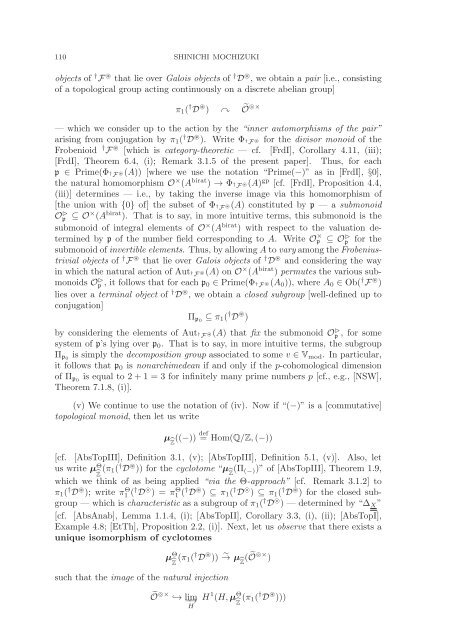Inter-universal Teichmuller Theory I: Construction of Hodge Theaters
Inter-universal Teichmuller Theory I: Construction of Hodge Theaters
Inter-universal Teichmuller Theory I: Construction of Hodge Theaters
Create successful ePaper yourself
Turn your PDF publications into a flip-book with our unique Google optimized e-Paper software.
110 SHINICHI MOCHIZUKI<br />
objects <strong>of</strong> † F ⊛ that lie over Galois objects <strong>of</strong> † D ⊛ ,weobtainapair [i.e., consisting<br />
<strong>of</strong> a topological group acting continuously on a discrete abelian group]<br />
π 1 ( † D ⊛ ) Õ⊚×<br />
— which we consider up to the action by the “inner automorphisms <strong>of</strong> the pair”<br />
arising from conjugation by π 1 ( † D ⊛ ). Write Φ† F for the divisor monoid <strong>of</strong> the<br />
⊛<br />
Frobenioid † F ⊛ [which is category-theoretic — cf. [FrdI], Corollary 4.11, (iii);<br />
[FrdI], Theorem 6.4, (i); Remark 3.1.5 <strong>of</strong> the present paper]. Thus, for each<br />
p ∈ Prime(Φ† F ⊛(A)) [where we use the notation “Prime(−)” as in [FrdI], §0],<br />
the natural homomorphism O × (A birat ) → Φ† F ⊛(A)gp [cf. [FrdI], Proposition 4.4,<br />
(iii)] determines — i.e., by taking the inverse image via this homomorphism <strong>of</strong><br />
[the union with {0} <strong>of</strong>] the subset <strong>of</strong> Φ† F ⊛(A) constituted by p —asubmonoid<br />
Op<br />
⊲ ⊆O × (A birat ). That is to say, in more intuitive terms, this submonoid is the<br />
submonoid <strong>of</strong> integral elements <strong>of</strong> O × (A birat ) with respect to the valuation determined<br />
by p <strong>of</strong> the number field corresponding to A. Write O p × ⊆Op ⊲ for the<br />
submonoid <strong>of</strong> invertible elements. Thus, by allowing A to vary among the Frobeniustrivial<br />
objects <strong>of</strong> † F ⊛ that lie over Galois objects <strong>of</strong> † D ⊛ and considering the way<br />
in which the natural action <strong>of</strong> Aut† F ⊛(A) onO× (A birat ) permutes the various submonoids<br />
Op ⊲ , it follows that for each p 0 ∈ Prime(Φ† F ⊛(A 0)), where A 0 ∈ Ob( † F ⊛ )<br />
lies over a terminal object <strong>of</strong> † D ⊛ ,weobtainaclosed subgroup [well-defined up to<br />
conjugation]<br />
Π p0 ⊆ π 1 ( † D ⊛ )<br />
by considering the elements <strong>of</strong> Aut† F ⊛(A) thatfix the submonoid O⊲ p ,forsome<br />
system <strong>of</strong> p’s lying over p 0 . That is to say, in more intuitive terms, the subgroup<br />
Π p0 is simply the decomposition group associated to some v ∈ V mod .Inparticular,<br />
it follows that p 0 is nonarchimedean if and only if the p-cohomological dimension<br />
<strong>of</strong> Π p0 is equal to 2 + 1 = 3 for infinitely many prime numbers p [cf., e.g., [NSW],<br />
Theorem 7.1.8, (i)].<br />
(v) We continue to use the notation <strong>of</strong> (iv). Now if “(−)” is a [commutative]<br />
topological monoid, then let us write<br />
μẐ((−)) def<br />
= Hom(Q/Z, (−))<br />
[cf. [AbsTopIII], Definition 3.1, (v); [AbsTopIII], Definition 5.1, (v)]. Also, let<br />
us write μ Θ(π 1( † D ⊛ )) for the cyclotome “μẐ(Π (−) )” <strong>of</strong> [AbsTopIII], Theorem 1.9,<br />
Ẑ<br />
which we think <strong>of</strong> as being applied “via the Θ-approach” [cf. Remark 3.1.2] to<br />
π 1 ( † D ⊛ ); write π1 Θ ( † D ⊚ )=π1 Θ ( † D ⊛ ) ⊆ π 1 ( † D ⊚ ) ⊆ π 1 ( † D ⊛ ) for the closed subgroup<br />
— which is characteristic as a subgroup <strong>of</strong> π 1 ( † D ⊚ )—determinedby“Δ X ”<br />
[cf. [AbsAnab], Lemma 1.1.4, (i); [AbsTopII], Corollary 3.3, (i), (ii); [AbsTopI],<br />
Example 4.8; [EtTh], Proposition 2.2, (i)]. Next, let us observe that there exists a<br />
unique isomorphism <strong>of</strong> cyclotomes<br />
μ Θ Ẑ (π 1( † D ⊛ )) ∼ → μẐ(Õ⊚× )<br />
such that the image <strong>of</strong> the natural injection<br />
Õ ⊚× ↩→ lim −→H H 1 (H, μ Θ Ẑ (π 1( † D ⊛ )))
















